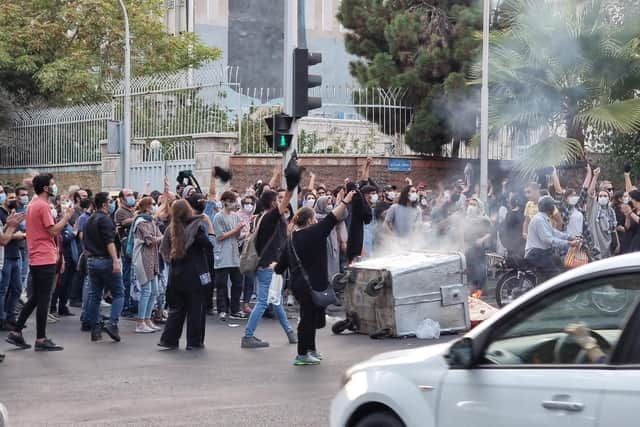Iranians may rise up again after 'morality police' allegedly beat 16-year-old Armita Garawand into a coma over hijab – Struan Stevenson


After huge crowds of people chanting “Women, Life, Freedom” took to the streets of Iran over the murder of Mahsa Amini, a young Kurdish woman, by the so-called ‘morality police’, the mullahs could have decided to respond positively and relax the oppressive laws about the wearing of the hijab. Instead, they decided to impose even tougher restrictions on women.
Now, with striking echoes of what happened to Amini, another young Kurdish girl has been left in a coma, after a confrontation with female morality police officers. Armita Garawand, 16, was left with severe injuries after being apprehended by agents of the notorious force at the Shohada metro station in Tehran, on Sunday.
Advertisement
Hide AdAdvertisement
Hide AdThough a resident of Tehran, Garawand hails from the city of Kermanshah in Kurdish-populated western Iran. She is being treated in Tehran’s Fajr hospital under heavy security. Even her own family has been prevented from visiting her.
Maryam Lotfi, a journalist from the state-run Shargh daily newspaper, sought in the aftermath of the incident to visit the hospital to report on the issue, but was immediately detained.
Mirroring what they said after Amini’s death, the authorities are denying that Garawand was beaten by the security forces and insist she simply “fainted” due to low blood pressure. The teenager’s parents have repeated this line but they are almost certainly under intense pressure from the mullahs.
When Amini died, the Iranian coroner's report denied her death had been caused by blows to the head and limbs while in the morality police’s custody and tried to link her death to pre-existing medical conditions, which her family flatly denied.
The mullahs need to hide the truth. They are terrified that another uprising may engulf their theocratic regime and sweep them from power. Following many months of protests that continued well into 2023 and led to the death of over 750 protesters and the arrest of more than 30,000, the mullahs have doubled down on security, hanging more than 600 people so far this year, in an attempt to frighten the population into acquiescence.


They remain on high alert for any upsurge of social tension. The case has become the subject of intense interest on social media, with a video of the incident appearing to show the teenager, with friends and unveiled, getting onto a train and then being carried off, apparently unconscious and having sustained a serious head injury.
Instead of relaxing their misogynistic dress code, the clerical regime’s authorities have launched a renewed push to crack down on women defying the Islamic Republic’s strict dress rules, including the mandatory hijab. According to the New York-based Centre for Human Rights in Iran, women and girls “face increased violence, arbitrary arrests and heightened discrimination after the Islamic Republic re-activated its forced-veiling police patrols”.
Lawmakers in Iran's parliament voted at the end of September for a Bill enforcing mandatory “Support for the Culture of Hijab and Chastity”, toughening penalties on women who flout the strict Islamic dress code. State media reported that under the new Bill, women failing to wear a headscarf or modest clothing face jail terms of up to ten years.
Advertisement
Hide AdAdvertisement
Hide AdSince Amini’s death, many Iranian women and girls have openly defied the law, some even cutting off their hair in mass public protests. In a predictable retaliation, the regime’s authorities have stepped up morality police patrols and have fitted thousands of surveillance cameras in public squares and shopping malls to detect female offenders.
Some businesses have even been closed for allowing women to enter their premises without wearing the headscarf. Women have been filmed in their cars by CCTV and summoned to the local police stations where they have to pay hefty fines for not wearing their hijabs. Repeat offences lead to imprisonment.
The politics of fear have been key to the Islamic Republic of Iran’s theocratic rulers’ hold on power for 44 years. Women cannot dance publicly, cannot drive motorcycles and cannot even travel without parental or spousal approval. They are prohibited from attending football or other men’s sporting events. The elderly and increasingly irrational Supreme Leader Ayatollah Ali Khamenei has even dictated that female cartoon characters must be properly veiled. The ageing leaders who came to power following the revolution in 1979 are completely out of touch with the new generation and young people that they fear the most.
Fearless Iranian women are at the forefront of the continuing upsurge in protests, demanding the overthrow of the theocratic and misogynist dictatorship. Young people have flocked to join the burgeoning resistance units of the People’s Mojahedin of Iran (PMOI) which now has a presence in every town and city in Iran. The PMOI resistance units have torched command posts and offices of the Islamic Revolutionary Guards Corps, the regime’s Gestapo.
They have destroyed regime effigies and banners of Ayatollah Khamenei and pasted up posters of Maryam Rajavi, the leader of the main democratic opposition, the National Council of Resistance of Iran, and the PMOI. Government websites have been hacked by resistance cyber experts inside the country and even national government broadcast channels have been interrupted with anti-regime and pro-PMOI messages.
The mullahs will be shuddering with fear that young Armita Garawand might die. It could be the spark that ignites a volcanic eruption of protest in Iran, sweeping the mullahs from power and restoring freedom, justice, democracy, women’s rights and human rights to 75 million Iranians who have suffered tyranny for too long.
Struan Stevenson, a former member of the European Parliament, is the coordinator of the Campaign for Iran Change and chair of the In Search of Justice committee on the protection of political freedoms in Iran. His latest book is entitled Dictatorship and Revolution. Iran – A Contemporary History.
Comments
Want to join the conversation? Please or to comment on this article.